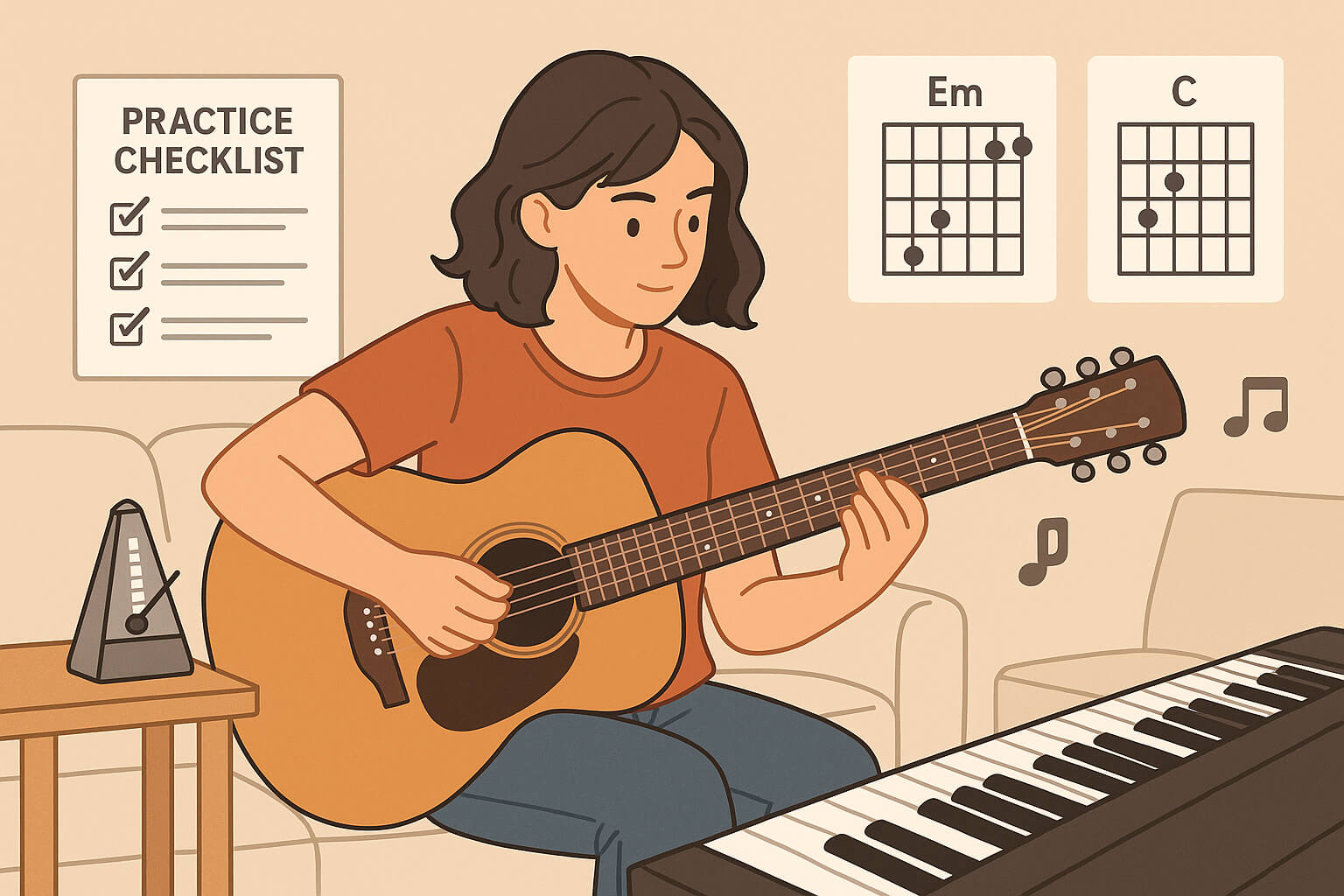Build Skills. Stay Motivated. See Progress.
Starting out as a musician is exciting—but it can also feel like there’s so much to learn. The truth is, you don’t need to master everything at once. What matters most is building a simple, focused, and consistent practice routine that targets the essentials, while still keeping the joy alive.
This guide will show you exactly what to practice as a beginner, so you can improve steadily without feeling overwhelmed.
1. Warm-Ups (5–10 Minutes)
Loosen up and get into the zone.
Warm-ups are like stretching before a workout—they help you ease in, avoid strain, and prepare for a productive session.
Try These:
- Scales and Arpeggios – Start with C major and expand as you go.
- Finger Exercises – Play spider walks or finger drills to boost dexterity.
- Breathing Exercises & Lip Trills – Warm up your voice or wind control with deep belly breaths and vocal slides.
Why It’s Important:
- Boosts finger independence, muscle memory, and coordination.
- Reduces tension or injury from cold starts.
- Signals your brain that it’s time to focus on music.
Keep it light and consistent—think of it as musical stretching.
2. Chords & Progressions (10 Minutes)
Learn the building blocks of songs.
Chords are your entry point to real music. Learning how to build and switch between chords will unlock hundreds of songs you already know and love.
Focus On:
- Major & Minor Chords – Start with easy keys like C, G, D, A, E, Am, Dm, Em.
- Open Chords – Practice transitions between C–G–Am–F and similar patterns.
- Simple Progressions – Try I–V–vi–IV, a progression used in countless pop hits.
Why It’s Important:
- Helps you play songs quickly and with confidence.
- Builds your foundation for songwriting, improvisation, or jamming.
- Strengthens your hands, memory, and chord recognition.
Practice switching chords slowly and cleanly—speed comes with accuracy.
3. Simple Songs & Riffs (10–15 Minutes)
Make it fun—play music you love!
Practicing real songs keeps you motivated and shows how theory and technique apply in real life.
How to Approach:
- Choose beginner-friendly songs (3–4 chords, slow tempo).
- Learn simple melodies or riffs with one hand, then try combining both.
- Sing along or play along with a backing track for timing.
Why It’s Important:
- Makes learning rewarding—you hear progress with each practice.
- Reinforces rhythm, coordination, and memory.
- Builds confidence as you play entire pieces from start to finish.
Break down tricky parts into small sections. Loop them until they feel smooth.
4. Rhythm & Timing Drills (5–10 Minutes)
Feel the beat—even without a metronome.
Rhythm is what makes music move. Even the simplest melodies sound better when played with solid timing.
Practice Ideas:
- Clap or tap along with a metronome or drum beat.
- Practice strumming, bowing, or drumming to different rhythms.
- Try reading and clapping rhythmic notation (quarter notes, eighths, rests).
Why It’s Important:
- Develops an internal clock for steady timing.
- Makes playing with other musicians smoother and more enjoyable.
- Keeps your music tight, natural, and expressive.
Don’t rush this—good rhythm is more important than playing fast.
5. Ear Training (Optional but Powerful)
Train your ears to recognize sound, not just read notes.
You don’t need to be a pro to start developing your musical ear. Start small and build awareness over time.
Try This:
- Play a note, then try to sing or hum it back.
- Listen to a chord and decide: Does it sound happy or sad?
- Practice recognizing intervals (the distance between notes).
Why It’s Important:
- Helps you play by ear, improvise, and write melodies faster.
- Builds intuitive understanding of pitch and harmony.
- Makes music more feelable—you’ll know what sounds “right.”
Even 5 minutes a day can make a big difference over time.
6. Cool-Down & Reflection (5 Minutes)
End on a high note and set tomorrow’s intention.
Instead of stopping abruptly, take a few minutes to play something you love and reflect on your progress.
Ideas:
- Revisit a favorite tune and focus on expression.
- Write a quick note: What improved today? What needs work?
- Celebrate small wins—even playing one chord better than yesterday counts.
Why It’s Important:
- Reinforces a positive habit loop around practicing.
- Builds self-awareness and progress tracking.
- Leaves you looking forward to your next session.
Consistency is more powerful than intensity. The goal is progress, not perfection.
Sample 30-Minute Beginner Practice Routine:
Here’s how you might structure your daily practice:
- Warm-Up: 5 minutes
- Chords & Progressions: 10 minutes
- Songs or Riffs: 10 minutes
- Rhythm or Ear Training: 5 minutes
- (Optional) Quick review or cool-down
Practice at the same time each day if possible—it builds routine and discipline.
Final Thoughts: Practice with Purpose and Patience
Being a beginner isn’t about being perfect—it’s about being consistent. The more you show up, the more your fingers, ears, and brain learn to work together. Start small, play with heart, and trust the process.
Your progress will come one focused practice session at a time.
Suggested Read Next:
